M o d e l i n g |
|
L a n g u a g e |
a review of:
MG Taylor Method language |
| In the period between 1975 and 1982, which were the seminal years of development of the MG Taylor Method, we developed a modeling language that enables us to describe our work and the phenomena associated with it with precision. This language is a key element of our patent and way of working. The development of this language is ongoing and will be so for a long period of time. What we have done is just tapped the first layer of a discipline of great depth. As this language is explored, the poverty of common language to adequately name and describe the active agents of creativity, innovation, collaboration and emergence become clear. When we refer to GroupGenius, we are not speaking metaphorically - we consider it a real phenomena and a state that can be consistently accomplished by disciplined effort. In the realm of organization the same is true of ValueWebs. This term is not a fancy word for networks. ValueWebs constitute an alternative organizational theory and practice which, we assert, is necessary if humanity is to effectively deal with the complexity that our own actions are generating every day. Without developing this language to a robust level, the mission of MG Taylor [link: mg taylor mission] in not conceivable, nor a possibility to be reached, nor is the work - demanded by the Method - possible. Without familiarity and some skill with the language, and understanding of the mechanics of Strong Memory and the Creative Habits, transfer is not possible beyond learning to do the simple basics by practice. |
| This Paper is a brief outline of this language - an introduction. The intent is to provide a basic familiarity with the language, its derivation and multiple uses. |
| As is always the case with my work, and particularity my personal web site, writing this was stimulated by real happenings in my everyday work experience - in this case a workshop on the Method that was done in Milan the first week of October, 2006, with members of the World Economic Forum and the Ales Groupe who own the NavCenter we were employing [ales_groupe_week]. |
| If you are new to the Taylor Method, it will be useful to review the materials directly provided below. A brief explanation follows each graphic and links are provided for more detail. The materials are: The MG Taylor Patent Tables; the Solution Box Model (including the Creative Process, Vantage Points and Design Formation); Strong Memory, the Creative habits, the 7 Domains, 4 Step Recreation and Creating the Problem Models. These models provide a foundation helpful to understanding how the Taylor Method employs models, which models are central to understanding the Method and how these model constitute a language useful for understanding creativity and GroupGenius. |
|
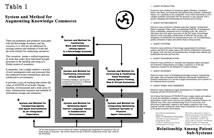 |
Tables 1, 2 & 4 - Table 3 is not yet published - illustrate several features of the Method.
Table 1 presents its basic scope. Table 2, the use of iteration, recursion and feedback, and also, the levels of language of the Method of which the Modeling Language is one level. Table 4 is an example the language use to outline a multi-month, multi-organizational PATCHWORKS design.
These Tables, along with the basic reading provided in ValueWeb Mechanics [link],provide a foundation for understanding the Method intellectually. There are other ways to access the Method which are described elsewhere.
click on the graphics
for a print version of each Table
|
|
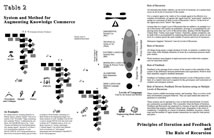 |
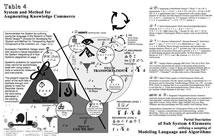 |
| I developed these three sheets in the summer of 1998 when I was preparing the final filing for the MG Taylor patent. My goal was to both explain and demonstrate certain aspects of the Method. In 2001, I had an opportunity to test the efficacy of both the language and its value in terms of the transfer of it. Having mostly completed the transfer to E&Y by the end of 1998, we had only occasional work with them until mid 2001. At that time, I was asked me to go to a number of their ASE environments and do a “refresher” course which was named the DNA Dip. The idea being to go into the history of the work and deeper into it than was possible in the beginning before they had a rich body of experience to attach the philosophy and science to. This was accomplished via a week long seminar repeated in 6 different locations in the US and Europe. This paper, is an modest example of some of the many aspects of the Method which were discussed on this tour. EY/Cap - the EY Management consulting practice having been sold to Capgemini by this time - KnowledgeWorkers came for all over the various regions to attend. This was a great opportunity for me to test several things about the Method itself and our way of transferring its use. |
| Those who attended represented KnowledgeWorkers who had worked with us for many years, people we had trained at E&Y and new members of the network who had been taught by second and sometimes third generation KnowledgeWorkers. |
| Of course, in the first phase of transfer, the interest on most people’s mind was on the nuts and bolts of doing the work. There were Fortune 500 clients, with high-stakes projects, to be served as learning and doing happened in real time. Philosophy and science were not on the forefront of everybody’s mind. There were some exceptions. These few took a deep dive into the history and theory of the practice. |
| When Gail and I first designed this way of working of the many specifications for it two were predominate. We determined that the end user participant should have to know nothing about the process in order to be successful in its use and that the provider should be able to reach a good level of competency of its basic practice by the experience of doing it and by tying this work to their prior education, fields of expertise and their general life experiences. We succeeded totally with the first. We succeeded partially with the second. We found that the provider did learn quickly by doing and were able to provide a good service, based on the Method, to end-users; however, absent learning the deeper philosophy and science - over time - the system of work was slowly pulled back into the prior norm and the host organization would kill this new innovation even as it praised its success. In other words, the old paradigm of work and organization would reassert itself. Knowledge, critical mass, organizational independence and a steady stream of demanding work with new kinds of challenges, are necessary for this way-of-working to “take” within a conventional organization. |
| For these reasons, with the DNA Dip events I was intent to go beyond the degree of theory transfer which was possible in the beginning day-to-day doing of the work and even the 7 Domains workshops that we do from time to time and made accessible to all KnowledgeWorkers in the network. I also wanted to test the fidelity of both multi-generational transfer and the retention, over several years, of the core principles of the work. One way I did this was my utilizing Table 4 (above). This plate is a Program and Schematic level - on the Design Formation Model - design of a very complex work. It is intended to convey this design while at the same time not inhibiting the emergence of further design development in later iterations of work. This is the practice of the 4 Step Re-Creation Model. This one sheet is highly compressed. It would take me at least two hours to convey verbally the information it contains and even then incompletely. I reasoned that if the language “worked,” and if the transfer process had been adequate, that I could give Table 4 to several different teams without any explanation and they would all be able to grasp the full complexity and intent of the design and each come up with an unique design - to advance the work - that displayed quality, values and originality. So, I did just that. In several of the sessions I gave it to multiple teams with no discussion at all - not even what the subject was nor what was the objective of the exercise. All of the teams came back in a couple of hours with a significant advancement of the design. All were valid and all were different. The interesting thing about this test is that the underlying architecture of the design is a PatchWorks structure/process and this was a development of the system that we had never mentioned, as such, in the original transfer to E&Y. |
| All the teams had was Table 4, access to the MG Taylor web site Modeling Language [link: modeling language] articles and the instruction to design the next iteration of the work to the Design Development level. The experiment was a great success in all regards and a deep satisfaction for me. This was a time that provided a sense that my work was indeed advancing. With an invention such as this Method, the feedback loops are long - often generational in length - and therefore it is not easy to navigate. We, of course, depend on the language, itself, to do this. |
|
| Steward Brand, co-founder of GBN, author, father of the Whole Earth Catalog and systems thinker, once made the remark that “people keep going the problem box for answers and all they find are more problems - they should go to the solution box.” We picked up on this idea with a workshop we gave, in the early 1980s on life planning, which we called the Building the SolutionBox. |
| As we developed the Modeling Language it became clear that one of the systemic difficulties people had was mapping, organizing and appropriately communicating key information about the many transitions a concept goes through from idea to realization. |
| I combined three of our Models into a 7 x 7 x 7 Matrix which creates a fine grained map - and specification of completeness - for each of these many transition points. Since this articulates a general solution process, we called this Matrix, in tribute to Steward’s insight, the Solution Box. |
|
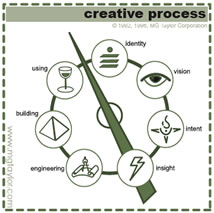 |
The Solution Box is composed of three models: The Creative Process, Vantage Points and Design Formation.
These form a matrix of 343 discreet steps each requiring their own unique language, criteria of veracity, work methods and tools. Many consider this too “complicated” and overly detailed a view. It is not. It is actually a simplification of an extraordinary complex process: human creativity in teams and large scale social organizations.
The reason why creativity and collaboration are still considered obscure and impossible to manage is that managers are still looking for “one minute” wisdom and want to “learn” how without any disciple nor investment. Nature will not comply.
The creative process is as demanding, exacting and complex as brain surgery. It is, unfortunately, not taught as a generality but in the disguise of specific disciples such as theater, architecture art - and, while not recognized as such - law, engineering, science, philosophy, mathematics and business.
click on the graphics for more |
|
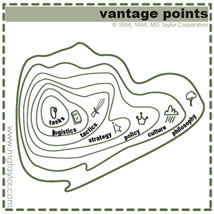 |
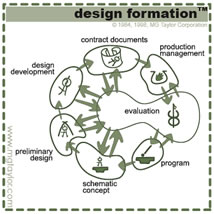 |
| There are several different kinds of use that the Solution Box Model can be put. The first, like any model, is for understanding of the system, components and parts/steps of, in this case, the process the model describes. The second is to employ it as an audit, specification and design tool for guiding the creative/innovation process. The third is to use this as a taxonomy for organizing a network of solutions to general, systemic conditions of our time. MG Taylor employs all there of these uses as an integral part of our Method. |
|
...Strong Memory and
the 22 Creative Habits
|
There are several ways the access the Taylor Method. each will appeal more to individuals depending on what kind of learner they are, their preferred working style and the circumstance in which they are approaching the work. Some like to start by just doing the work in some form that it might take, as example, a DesignShop exercise. Others by getting deeply involved in the theory of it - its language and philosophical, scientific and technological aspects. The third way is is what I call the side door. This is to understand two vital aspects of the Method - the creation of Strong memory and the Habits of Creative People - and to learn how to embed these into the 7 Domains that make up the environment of any task project or event. Naturally, all three of these access routes should be employed and their various insights and tool-kits integrated. It is much easier and fun, however, to start from a framework which is inherently comfortable. In broad terms, kinesthetic people who learn with their “hands,” and like to keep moving, will do best starting in a Taylor environment doing the work for real clients. Once the pattern of the Method - as applied to one kind of work or process - is clear to them then the other aspects of the theory and practice open up for them. The intellectually oriented usually do not like to do until they have a framework in which to put the experience. In fact, they can become quite resistant to being asked to do anything without understanding the “why of it” in some detail. For the visual or what is (often falsely) called the “artistic,” imagination is the better route. Armed with a notional understanding of the 7 Domains model and a description of Strong Memory and the Habits, they can “invent” on their own in their own mind a place for a new way of working. This is actually an application of the 4 Step recreation Model. Then they can, with this design and specification in mind, access the more didactic and experiential aspects of the work. |
| Again, I emphasis that all three approaches are necessary to fully embrace the work. Also, it should be remembered that when building a place for others to work that this range - and greater - of learning and doing types will be walking into the door. The environment, processes and tools provided must provide entry points for every one of the many human intelligence modalities. Every Taylor designed, built and operated environment is dedicated to this principle. |
| The philosopher Alfred Whitehead said that the purpose of philosophy was not to “prove” something but to give it a “name - an identity - so that someone would could say, based on their own experience - “yes, that is what I know.” The Taylor Method does not believe that complex concepts and ideas can be passed from one person to another as knowledge. I may be able to stimulate you thinking and present information that provides grist for it, but you have to recreate in you mind and tie it to you own experience before it will have real value [link: the 5 Es of education model]. Learning it not passive and one of the great sins of our time is that Universities are cranking out multitudes of graduates with all the accouterments of learning without the real essence of it. An overly technically trained individual without engaged individual and group thinking processes and adequate experience is dangerous to self and society. This is how, for example, perfectly wonderful damns get built in the wrong place and subsequently wipe out the ecology of an entire region - or worse, when “rational” policies get applied in economics and government to produce socially destructive consequences which were never their intent. Education means “to lead out.” Training, while necessary, is not education. |
| The idea of Strong Memory is simple and its application easy. The science behind it is complex but a little self reflection and observation of both humans and animals can do wonders in regards understanding how mind actually works. Memory as a physical and virtual system is largely associative. It is a network architecture where memory elements are connected to like elements. You do not remember you regenerate an experience and, connected to this emotionally, physically and intellectually, are many aspects of those prior experiences that a given re-call is associated with. This act of remembering becomes part of the memory. Memory, thus, is rich and ever changing. So is your response. Where, a memory is held - in the brain-mind, social artifact and morphology, and ecological system - is important in terms of its future effect on how you think and act. Territory matters. Memory is metaphysical and physical. It is real. A memory is effected by what your are doing physically, including where you are, as well as your mental state at the moment it is made. It is connected by a variety of different kinds of communication systems within you and without of the “skin” you identify as yourself - be that skin you, your group, community, nation, world or universe which are all active levels of recursion whose relevance to any specific memory is contextual both in the making and re-member-ing of it. Your normal awareness of memory (and thinking in general) is predominately through your conscious facility which is, by far, the smallest and most limited aspect of your mental and physical capabilities [link: 22 aspects of strong memory]. A primary goal of the Taylor Method is the making, within an appropriate [link: appropriate response model] ethical framework, of Strong Memory. |
| Within the context of this work, a weak memory is new information/experience received in a passive way and connected to prior such moments, partial or false information, repressed emotions, jumbled neural architecture, and negative experiences. These are more difficult to re-call and bring a great deal of baggage “back” with them. Emotionally, the memory tends to be discounted. Its connection to “new” experiences can corrupt the cognitive process involved. In contradistinction, a Strong Memory is active, its neural pathways remain exercised, the connections are rich both in number and in strength, the emotional aspects are strong, re-cognized and positive even if related to a “negative” event. A Strong Memory is connected to vigorous physical and mental past experiences and mental constructs of a positive, actionable future. It employs the full “multimedia” capabilities of the mind: emotion, intellect, visual, kinesthetic, proximity, movement, touch, feel, sense, color, sound - and more. Strong Memory has elements of rapture, enlightenment, insight, passion, conviction and action. If you had a great idea to offer to a group, where would you want them to re-member it? If you want them to remember it in a strong way, offer it in a way that attaches it to their fullest experience of creative being in an expanding benevolent universe. |
| The 22 Habits of Creative People are equally easy to understand as is the idea of Strong Memory. Again, relate to your own experience of your creative life. We all experience our creative processes differently - this is why they are considered to be subjective. Subjective, in this context, should not be considered in a negative light as has become the habit in our society today. If you look at the Creative Process Model, you will see that we consider the entire first half of it - at the scale of the total process - to be subjective. This half does has objective aspects, on recursion levels, just as the second objective half has subjective elements. I bring this up because it is the misunderstanding of and the mismanagement of the subjective and objective aspects of thinking and creative being that constitutes some of the most formable barriers to the proper exercise of both. It turns out that when you study the biographies of those who we universally recognize as being greatly creative, there are certain habits shared by the majority of these exemplars across, sex, culture, time and fields of effort. I use the term “habit” for two important reasons. First, we all function most of the time by habit. If we did not, we would not be able to function. These are learned. Some by couscous effort - most by social osmosis. A disciple, or a craft, is the consequence of idea, intentionally and technique embodied in a habit of thinking and working. Habits are good. They also are dangerous for obvious reasons. Second, how most creatives report what they do is always suspect - useful, valuable - if taken in context - but rarely complete. A good biography has to establish a historical period, the background of a person and peer group, the issues of the times, how the subject of the biography responded - and why - the technology/technique (in the sense of these concepts root meaning) s/he employed, the struggles involved to make something new, failures and triumphs, and the social consequences of a life. My 22 Creative Habits [link: the 22 habits of creative people] are the distilation of 55 years of reading biographies, relationships I have had with remarkably creative people, and a quarter of a century of facilitating large group processes. I do not claim these to be the only habits of creativity - nor even the most significant. They are habits - ways of being and working - which cut across an extraordinarily wide sample base. They can be applied as principles - design strategies - and embedded into environments which consistently promote high levels of individual creatively and GroupGenius®. We have done this for decades and any research into the results will produce testimony of the efficacy of this approach beyond any reasonable doubt. |
| Clearly there are many connections between memory and creative habits. One of the most obvious and important to grasp is the tight relationship between them: the habits are how, memory, the body-mind, society and technology are used as a tool in the creative process. Please do not pass over this thought too quickly or take it as a glib remark. Take it literally. Think about the implications of it. Use it as a principle when designing learning/working environments. |
| It is the idea of embedding that takes a little thought, but once grasped, its application is limited only by your imagination. At MG Taylor, we have a saying: “Structure Wins.” We do not consider structure and process to be different. They only appear to be different from the vantage point of some fixed time scale and level of observational fidelity. A “structure” is just (to an observer) a slow moving process and a “process” a fast changing structure. A piece of steel sitting on my desk is actually evaporating in the oxygen corrosive atmosphere of air - Is it a structure or a process? To me it appears to be fixed - as structure and object. If my metabolism was operating at a different rate, I might think of it as burning like a log in a fireplace. The idea is to look at the 7 Domains of the Method - as structure - and to build-in the characteristics of the Creative Habits. For example, creative people, almost universally, have the habit of working - during the incubation period of an idea - extremely long hours though multiple iterations of success and failure, excluding random, distracting, elements from society at large. So, in a DesignShop process, we put the participants into an isolated environment made up of “alien” elements and symbols (“Dorothy, we are not on Kansas anymore”) that cannot be related to their “normal” workplace, work teams long hours, through the exhaustion cycle, and though many iterations of work. This is but one simple example of thousands. |
|
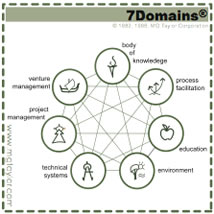 |
The 7 Domains Model describes the aspects to be managed to create an environment conducive to emergent, creative behavior. The basic insight of this Model is from Bucky Fuller: “don’t try to change the behavior of people, change the environment around them.”
click on the graphic for more |
|
| People do not need to be managed. Manage the environment in which, in this case, they learn and work. Make this a natural, high variety, organic, fun, supportive, evolving, stimulating place where appropriate work disciples are embedded in the very fabric of the architecture. Operate this environment - use it as a tool [link: the monkey’ paw] - to facilitate the emergence of new solutions to systemic problems. Create ValueWebs [link: valueweb mechanics] of people, organizations and capacities capable of conceiving, developing and executing this kind of work. This is exercising the 7 Domains in a robust way. If in our work, at MG Taylor, we can transfer a Method which helps you, with your organizational mission, and also builds a ValueWeb of like capability across the globe, we will have succeeded in our mission [link: mg taylor mission]. This is Venture management where it is most needed and presently most absent: the management of the human venture [link: a testament]. Failing to do this, is to create a future by default [link: a future by...] and, thus, pay whatever the price will be at the time the bill is presented. The 7 Domains Model has to be applied on all seven levels of recursion [link: taylor method recursion map] of the Method in a way that is personally relevant to each individual and the organizations of which they are a part. |
|
4_step_and_creating_problem |
...4 Step Recreation and Creating the Problem Models |
| Two models remain and we will have established a primary language useful for exploring the modeling language in a general way. Both of these are at the very heart of our Method. These are deceptively simple models and easy to either dismiss or casually accept too easily without sensing their radical nature. |
|
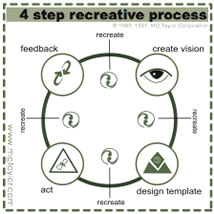 |
The 4 Step Recreation Model addressed the media an idea is inbedded in during various times of its development. It states that the idea must be totally recreated every time it changes its form in media. The is because of the requsitite variety issue.
The Creating the Problem Model distinches between a condition which most call a problem and a formal problem statement which is a good thing as it is definable, solvable, useful when solved and something a community has passion about.
These two models turn upsidedown the way that the vast majority think about problem solving.
click on the graphics for more |
|
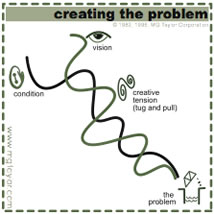 |
| When Steward Brand made his remark about going to the “solution box” his use of the terms “problem” was conventional. The shift inherent in his remark was that problems lead to “solutions” which led to more problems and this is certainly the history of things. His idea of going for the solution, as a first step, is a departure from conventional thinking and process. We describe this in our Axiom: You can’t get THERE from here but you can get HERE from THERE.” Our Building the Solution Box workshop emphasized that from the solution box the appropriate problem had to be created and then solved. That when people “solve” conditions, which are unbounded, they generate more conditions many of which are undesirable. Creating a proper problem is the most challenging aspect of the creative process and is not accomplished until stage 4, synthesis/Insight, in our model. In a 3 day DesignShop® process, the problem is created on the afternoon of the second day. This focus on proper problem creation is unusual in our society. |
| The issue of variety and complexity is embedded in the 4 Step Recreation Model Like all the models, this can be applied at different levels of recursion. It can be applied as a thing in itself or seen as a subsystem step in the transition from any step or stage of any of the Taylor models. The heart of the matter is that the media by which an concept is held and communicated has a profound effect on its complexity and representation. Most assume the idea is the “same” no matter the form of its presentation. This false-to-fact leads to many confusions. |
| Let us say I am building a building. My first idea of it will be in the media of mind. Here I have over 10 to the 10 brain cells in a multimedia environment that escapes time, sees in color, hears sounds, has tactile experiences to be referenced and holds the context, in my case, of over 50 years of designing and building buildings. Great complexity can be held in any simple thought as concepts “chunk” huge amounts of information. When I try to present by idea in a sketch I am now working in a two dimensional, linear environment of simple means. If I try and “copy” what is in my mind into this far simpler media I will fail. I have to recreate the idea in the form of this media. I have gone form high variety to low variety. This forces me to find the essence of the idea and present it in a way the provokes understanding. When I take my drawing to the next form, the act of building, I am now in a complete social environment and a world of things, economics and other pressures. High variety. If I try to impose my design on this socially complexity, again I will fail. It must be recreated again. The same holds true for use, evaluation and feedback. I cannot undo the past, I can only recreate the idea again. The feedback cannot go “back,” it can only be feedback to the idea in my mind and, of course, it is a different mind because of the experience. The failure to understand that an idea has to be recreated at every transition point is the cause of “writers block” and the overwhelming tendency for a concept to be destroyed on the long path to realization. In between each of the 343 transition of the Solution Box, a concept has to be recreated, in both content and form, if it is to remain viable. |
| A working familiarity with the material outlined above gives us a base language to now explore the MG Taylor use of models as a language. |
|
This has been a long introduction to our subject of how the modeling language can be used as a language but notice, to some extent, this has already been demonstrated. As a language, the models and their components, have to be employed, simultaneously, on a minimum of three levels of recursion. At the base level, are the glyphs you see in each of the Models. Then there is the level of the Models themselves. The third level is that of the models “interacting” with each other. A simple way to think about this is as words, sentences and paragraphs - although this should not be taken too literally. |
| The sample, Table 4, used as the masthead of this paper, employs all three levels. It describes a complex process architecture. It can be understood only if each component is understood in relationship to all of the other components. There is nuance in the placement of the components on the sheet. Size has meaning. Color was not used with this example but could be and this can provide another whole layer of meaning. This is a visual language the idea of which is to show relationships that word oriented language cannot easily do. One qualification about Table 4. The day I made it up I was sitting at my workstation on Camelot, in 1998, having just finished the HyperCar DesignShop. I had a few hours to do this piece to meet a filing deadline on the patent. So, I just made this up more or less out of thin air based on the idea of what would have made a good PatchWorks follow up to the event. This does show a use of the language but it should not be taken as anything more than a simple example - it is not “deep” nor is it particularly robust. |
| The idea to keep in mind when thinking about, making and applying a language of this sort is that of “Chunking.” The objective is to get the greatest amount of information embedded in the simplest form so that each of these bits can be shown in a graspable architecture which holds a great amount of information that can be “seen” in an instant. The architecture itself - the arrangement of the bits - has meaning. This is, of course, just doing, in a visual format, what concepts and words do with verbal language and writing. This is based on how the minds works as a system/process. It is applied organic design and an example of Biomimicry. The greater the abstraction and the better the relationships are diagrammed, the more information contained in the picture. “A picture is worth a thousand words” points to the information compression made possible. This compression is important because the amount of symbols the mind can comprehend and manipulate is limited. If more symbols, all with a rich trail of meaning, can be effectively presented in a way that can be held “whole” in real time, then a greater complexity of meaning can be made simple. Imagine trying to build a building without drawings and by verbal description or engineer a bridge without equations but by words alone and the potential of this can be appreciated. |
| Part Two of this Paper will address various aspects of the Modeling Language craft and its application to the Taylor Method and creative processes in general. |
|
|
| GoTo: MG Taylor Modeling Language 2 |
|
|
|
|
| GoTo: INDEX - Matt Taylor Papers 2006 |
|
|
|
Matt Taylor
Nashville
October 10, 2006
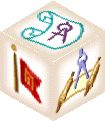
SolutionBox
voice of this document:
ENGINEER • STRATEGY • CONSTRUCTION DOCUMENT
|
posted:
October 10, 2006
revised:
October 14, 2006
• 20061010.651930.mt • 20061012.453100.mt •
• 20061014.341000.mt •
(note:
this document is about 95% finished)
Copyright© Matt
Taylor 1979, 1981, 1982, 1998, 2001, 2006 |
|
|